Why will traditional assets fully outperform cryptocurrencies in 2025?
Author: Rhythm Junior Worker
Original Title: After a Year of Crypto Trading, My Returns Can't Match My Mom's A-Share Gains
This is a year when "everything is rising," yet the crypto world is widely recognized as "extremely hard to make money" this year.
Compared to previous years, 2025 seems like a rare "prosperous year." The US Nasdaq hit new highs, core assets in A-shares rebounded, gold reached historic prices, commodities collectively rallied—almost every market is up.
Only in crypto, even with bitcoin hitting a historic high of $120,000, many people still complain that this is "the hardest year to make money in crypto." A friend mentioned their family's investments this year, saying, "This year, my crypto trading returns are completely outperformed by my mom's A-share trading."
A-Shares: The Once-in-a-Decade Main Uptrend
"This year, both my own and my family's A-share accounts have a 100% win rate." In the finance department of a university in Hangzhou, Professor Cai, who has researched and taught about the A-share market for over 20 years, told Rhythm BlockBeats.
"The stock market has been strong, and most investors are profitable. Compared to previous years, it's much easier to make money in the stock market this year. As long as you don't chase highs or buy delisted stocks, you basically make money no matter what you buy—it's just a matter of how much."
If Professor Cai's experience is "the intuition of an old hand," then his students' data is even more convincing: "Among the students I interact with frequently, many have made a lot. Those who traded more than 20 stocks all had a 100% win rate."
The data also confirms this "broad rally" trend.
In the first three quarters of this year, according to China's mainstream industry classification standard, 28 out of 31 sectors under the Shenwan primary industry classification rose, accounting for over 90%. Wind data shows that over 80% of stocks rose during the year, with as many as 448 stocks doubling in price.
"Another feature of this year's A-share market is: both volume and price rose. Not only was the price performance good, but trading volume was also huge, especially in the third quarter, with several consecutive trading days exceeding 2 trillion yuan in turnover," summarized Zhuo Chen, a long-term A-share investor, to Rhythm BlockBeats.
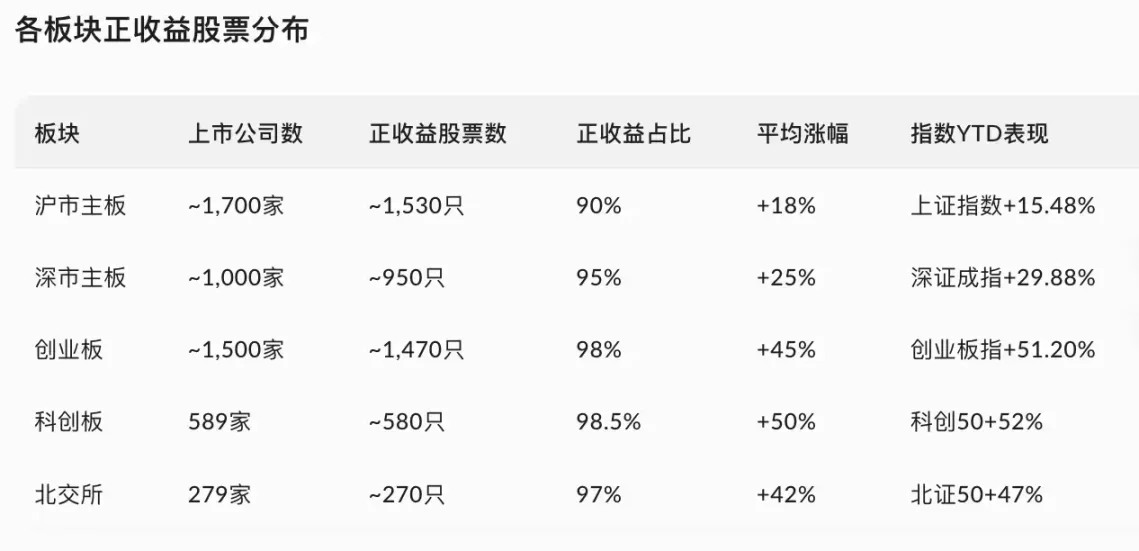
Compared to the main board, the ChiNext and STAR Market saw even more intense gains.
"This year, the artificial intelligence sector led the rally, so the corresponding indices for innovation boards, such as the ChiNext Index and STAR 50, all rose more than 50%," said Zhuo Chen.
A representative stock is "Shangwei New Materials," the first "20x monster stock" in this year's A-share market.
"This was originally a chemical company on the STAR Market. The surge was triggered by an announcement that the controlling shareholder changed to Zhiyuan Hengyue, a company closely related to Zhiyuan Robotics, which is part of the AI sector."
Note from Rhythm BlockBeats: Zhiyuan Robotics is a star company in the "embodied intelligence" track, co-founded by former Huawei "genius youth" Peng Zhihui (Zhi Hui Jun) and former vice president Deng Taihua.
This news ignited the market's imagination. On social media, headlines like "Zhiyuan Robotics Backdoor Listing" and "A-share Version of Nvidia" emerged one after another. Although the company repeatedly clarified that there were no short-term asset restructuring plans, the sentiment had already been set ablaze.

In just 17 trading days, the stock price soared from single digits, rising more than 13 times. As of September 25, Shangwei New Materials had risen over 2030% for the year, becoming the first "20x stock" in the 2025 A-share market.
In Professor Cai's view, this year's A-share market boom is not abnormal.
"It's just that after a big drop, it has to rise. From a time cycle perspective, the A-share market has a bull market about every ten years. Last year was the transition from bear to bull, and this year is the main uptrend of the bull market," said Professor Cai.
In the 2005 bull market, the Shanghai Composite Index rose from 998 in 2004 to 6124 in 2007; in the 2015 bull market, it rose from 1849 in 2013 to 5178 in 2015. The interval between these two bull markets is basically about 10 years, and now another decade has passed.
"Moreover, almost all overseas markets performed extremely well this year," Professor Cai added. "From Japan to Germany, the UK, India, the US, Canada, and other major markets, all hit historic highs."
Hong Kong Stocks: Even Elephants Can Turn Around
Before looking at US stocks, let's look at Hong Kong stocks first.
As of this writing, the Hang Seng Index has risen nearly 29% for the year, breaking through 26,000 in September and hitting a four-year high.
Tech giants once again became the main drivers of this rally. The internet sector, represented by Alibaba, Tencent, Meituan, and Xiaomi, led the gains, pushing the Hang Seng Tech Index higher.
People often say "elephants can't turn around easily," but this year's market is a bit of an exception.
For example, many people were not optimistic about Alibaba's rally at first. After all, it had fallen so hard in recent years that it almost became synonymous with the slump in Chinese internet stocks.
But since the beginning of the year, Alibaba Cloud achieved double-digit growth for two consecutive quarters, with a 26% year-on-year increase in Q2, the highest in nearly three years. Its AI business has maintained triple-digit growth for eight consecutive quarters. Reflected in the stock price, Alibaba's share price doubled this year, making it the brightest among large companies.
On the other hand, Tencent was also impressive. In Q2 2025, Tencent's domestic gaming revenue grew 24% year-on-year, and its advertising business saw a 20% boost thanks to AI algorithm optimization. Since 2024, Tencent expanded its buyback program to 112 billion HKD, the largest in nearly a decade. Tencent's share price also rose over 50% this year, with its Hong Kong market cap returning to 6 trillion HKD, nearly tripling in three years.
Besides this, the most notable thing in the Hong Kong market this year is the profitability of IPO subscriptions.
"This year, making money from one IPO is like outperforming others' half-year trading," Arez said in a chat with Rhythm BlockBeats.
The data speaks for itself.
In the first three quarters of 2025, 68 new stocks were listed in Hong Kong, of which 48 rose on the first day, 4 closed flat, and only 16 broke issue price, with a first-day break rate of just 24%, the lowest since 2017.
Especially in the second half of the year, among the 24 new stocks listed from July to September, only 3 broke issue price, and the profitability was obvious. Correspondingly, the average first-day return rate soared to 28%—almost three times last year's rate.
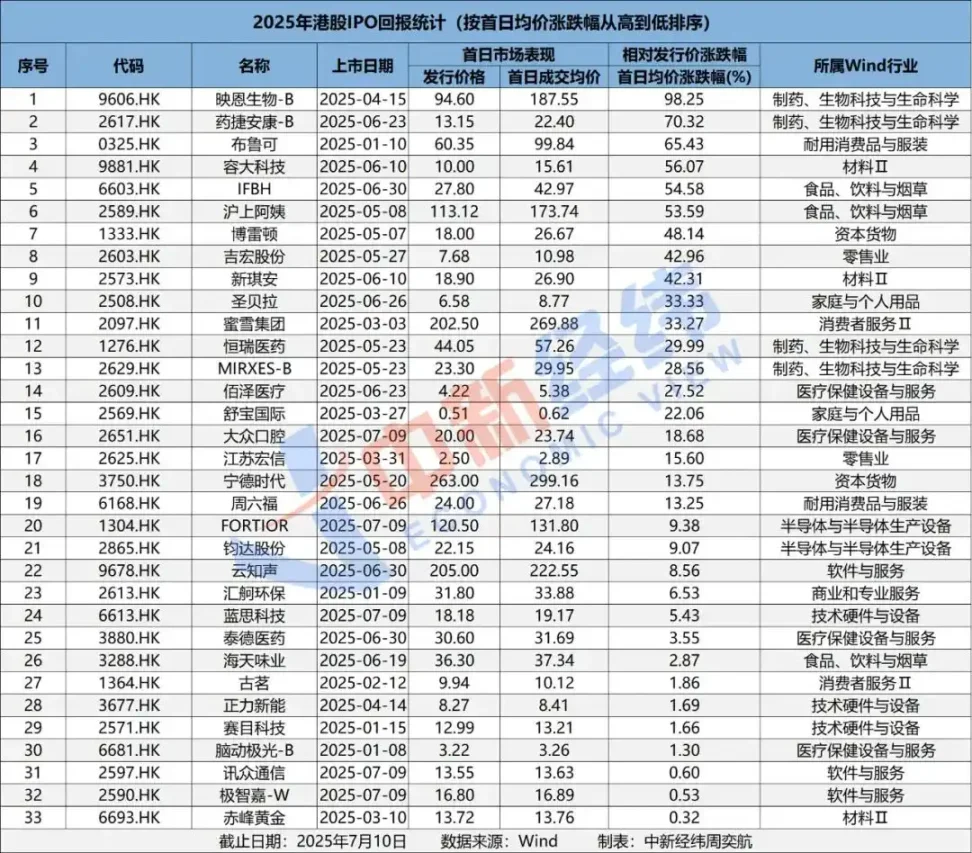
"The profitability of Hong Kong IPO subscriptions was already evident in the second half of 2024. For example, Maogeping rose 70% on its first day, kicking off a mini bull run for IPOs, and this year it's a full-blown rally,"
Arez also spoke with Rhythm BlockBeats half a year ago. Because the crypto project's airdrop farming track was sluggish, their studio set up a dedicated Hong Kong IPO group to handle IPO subscriptions.
"We won allocations in Blue Orca, Mixue, Shanghai Auntie, Ning Wang, InnoCare Pharma, and others. This year, it's very easy to make over 100,000 from IPOs. For example, a big allocation like InnoCare Pharma can make you 10,000 per lot, and many banks and brokers offer 10x leverage, so capital utilization is also high," said Arez.
"Moreover, there are especially many A+H model IPOs this year, so it's very stable to operate." Several leading A-share companies went public in Hong Kong this year, such as CATL and Hengrui Medicine. Since A-shares already have mature pricing, Hong Kong IPOs are often issued at a discount, providing a "valuation safety cushion" that greatly reduces IPO risk.
"For example, the profit from CATL's IPO was like picking up free money," Arez laughed to Rhythm BlockBeats. "Everyone knows Hong Kong stocks are discounted, but no one expected the discount to be this sweet."
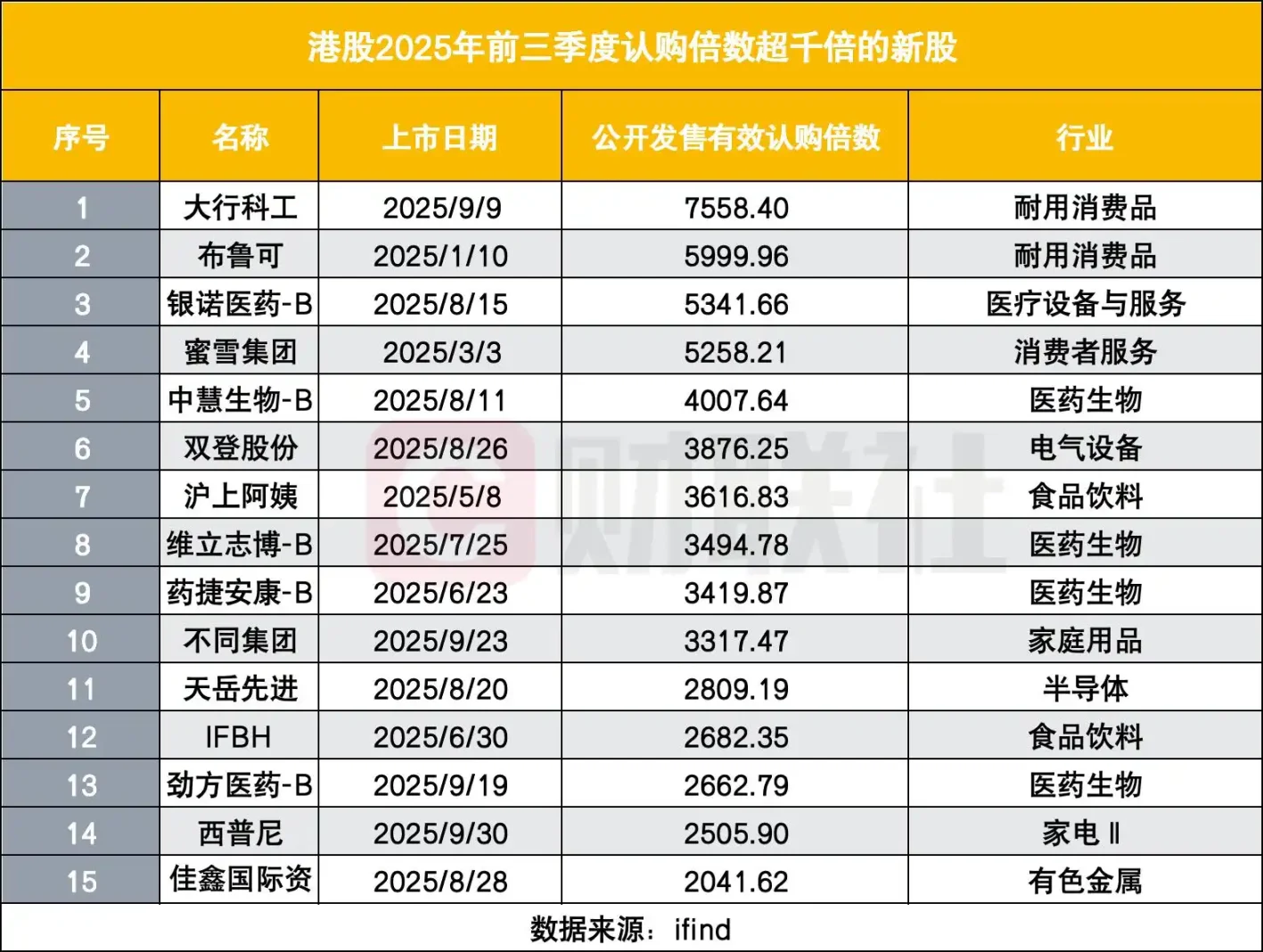
As the profitability became apparent, Hong Kong IPO subscriptions even showed a trend of "going mainstream." Compared to last year, this year's Hong Kong IPO market is much livelier, with oversubscription moving from the hundreds to the thousands. "The most extreme was Dahang Technology, which was oversubscribed nearly 8,000 times."
Statistics show that in the first three quarters of 2025, 68 new stocks were listed in Hong Kong, 98% of which were oversubscribed, and 86% had oversubscription multiples over 20 times, double the proportion of the same period last year. There were 15 stocks with oversubscription multiples over 1,000, accounting for nearly a quarter.
Among them, Dahang Technology led the pack with an effective public offering subscription multiple of 7,558, becoming the "subscription king" of the season; Blue Orca and InnoCare Pharma followed closely, recording 5,999 and 5,341 times, respectively. Against this backdrop, Hong Kong IPO subscriptions have become the new generation of "risk-free wealth management."
Gold: Everyone Is Looking for Certainty
On the other end of capital, gold is soaring.
Starting at $2,590 per ounce at the beginning of the year, gold hit its annual low on January 3 and then climbed steadily, breaking historical highs several times and now stabilizing around $4,100, up more than 58% for the year.
The S&P Global Gold Miners Index soared 129%, making it the best-performing sector among all S&P industry indices. Even silver prices surged to their highest in decades, up more than 70% this year.
The driving force behind this precious metals bull market is not just risk aversion. US government shutdown risks, continued central bank buying, concerns about sovereign debt expansion—all macro narratives point in the same direction: money is looking for a safer container.
"For gold miners, this has been a fantastic year. They have so much cash they don't know what to do with it," Zhuo Chen remarked in the interview.
Zijin Mining, the largest gold company by market cap in A-shares, is a representative of this feast.
By the third quarter, the company had revenue of 254.2 billion yuan and net profit of 37.864 billion yuan. If you combine the A-share and Hong Kong market caps (i.e., A+H total market cap), Zijin Mining's total market cap has exceeded 1 trillion yuan.
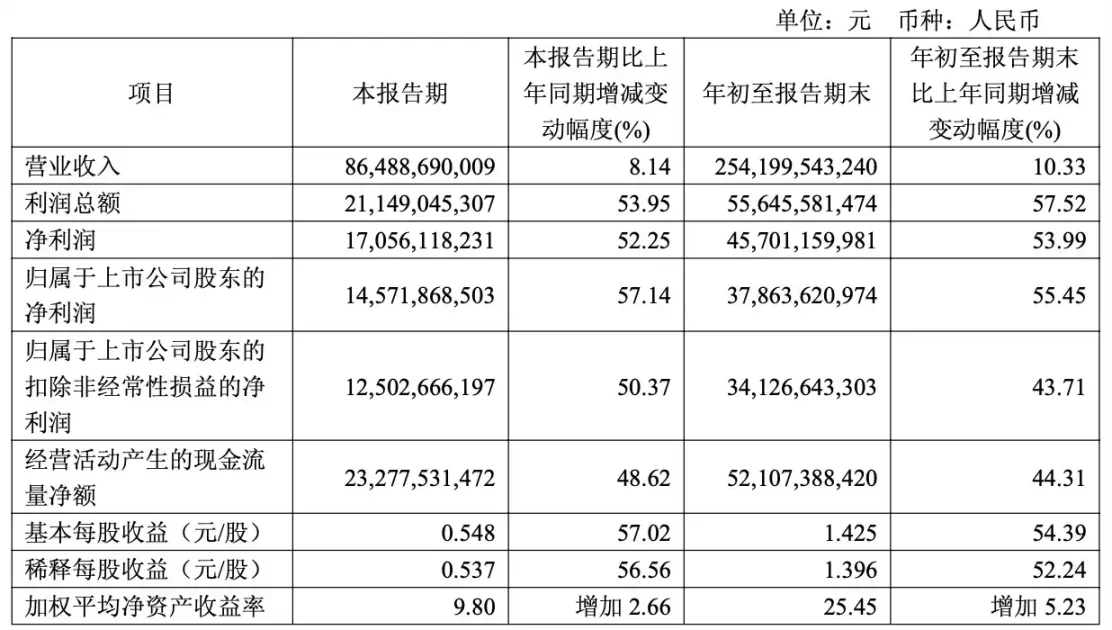
Source: Zijin Mining Q3 Report
So at the end of August, Zijin Mining spent a huge sum to acquire 84% of Anhui Jinsha Molybdenum, securing the world's second-largest molybdenum mine—Shapinggou Molybdenum Mine, with an annual capacity of 10 million tons.
This deal gave China direct control over one-third of the world's molybdenum resources.
Almost at the same time, Zijin's "Zijin Gold International" was listed on the Hong Kong Stock Exchange on September 30, doubling on its first day and becoming the second-largest IPO of the year.
Not only the A-share gold sector, but the best-performing US stock sector this year is also gold miners.
Data shows that since the beginning of the year, Newmont's share price has risen 137%, Barrick is up 118%, and Agnico Eagle is up 116%. By comparison, Nvidia, the star of US AI stocks, is up 40%, Oracle is up 72%, Alphabet (Google's parent) is up 30%, and Microsoft is up 25%.
Although the US gold sector's gains are outstanding, they don't cover all the gains in US stocks this year.
The Revival of Meme US Stocks
By late October, all three major US indices had risen more than 20% for the year. The S&P 500 hit a record closing high of 6,753.72 on October 8. Nvidia's market cap surpassed $4 trillion, and Microsoft, Meta, and Apple all reached historic highs.
Besides these mainstream US stocks, Matt, who frequents US stock forums like Reddit's "WallStreetBets" and "StocksToBuyToday," witnessed a new wave of meme stock frenzy and shared some of this year's meme stocks with Rhythm BlockBeats.
"If I had to name the biggest meme stock on Nasdaq in the past three months, I'd say it's OpenDoor, very similar to GameStop back in the day. It rose 245% in July, 141% in August, and 79% in September, with the price going from $0.5 to a high of $10.87, a maximum increase of 2,000%." Matt's tone became noticeably excited at this point.
Interestingly, this instant real estate trading company has been losing money every year since its founding, with its share price falling from a 2021 high of $35.8 to $0.5 in June 2025, and it even received a delisting warning from Nasdaq.
"The turning point came when a well-known investor said on social media that OpenDoor had the potential to be a 100x stock, attracting a group of retail investors on Reddit called the Open Army, which directly pushed the stock price to rocket up. They crowned OpenDoor as the new meme stock and even successfully 'forced' a board reshuffle."
Another meme stock Matt recently participated in was Beyond Meat, once the "leader in plant-based meat," whose share price soared 1,100% in a few days. "Again, it's been losing money for years, with institutional short interest as high as 80%. But the more institutions dislike it, the more retail investors love it—that's the power of retail investors."
Interestingly, one of the best-performing US stock sectors this year is still related to crypto—but not cryptocurrencies themselves.
Compared to the dazzling performance of "bitcoin concept stocks," bitcoin's own gains look much less impressive. Even though bitcoin hit a new all-time high this year, its annual gain is only about 15%.
The Crypto World's Stall
Anything with a price can't keep rising forever.
And after multiple rounds of narratives, the crypto world has become a "market without a main storyline."
While traditional capital markets have found new growth logic in AI, energy, and manufacturing, the crypto world remains trapped in its own self-referential cycle.
The decline in trading volume says it all. In Q3 2025, global centralized crypto exchange spot trading volume fell 32% year-on-year. Retail sentiment has been worn down, market makers are no longer active, and market depth has decreased.
On-chain funds are dormant, token prices are flat, and project teams are silent. Even on social media, there are fewer complaints about troubled exchanges.
The crypto world, full of get-rich-quick myths, has become a "subject of self-exploitation." Watching the market 24/7 because "opportunities wait for no one"; frantically chasing airdrops, meme coins, and hot topics because "if you don't work hard, you'll be eliminated"; blaming yourself for losses for "not being smart enough," and feeling "it's never enough" when you make money.
Three quarters have passed in 2025, and effort has lost its feedback, so burnout is inevitable.
"Those who should leave have left, and those who remain don't want to gamble anymore." Arez's pessimism about the crypto world seems to represent many people. "In 2024, I still watched the market on-chain, but this year, I don't even have the desire to open a trading platform."
The crypto world has indeed lost this year. But what it lost was an inevitable battle within the cycle.
When the macro environment gives traditional assets a clear upward logic, when tighter regulation raises the cost of speculation, and when exhausted narratives stop attracting new money—the crypto world's slump is almost inevitable.
But this doesn't mean the story of cryptocurrencies is over.
"If you believe in China's national fortune, invest regularly in the CSI 300; if you believe in China's tech breakthroughs, invest in the STAR 50; if you believe in America's national fortune, invest in the S&P 500; if you believe in the human technological revolution, invest in the Nasdaq. If you believe humanity is doomed, invest in gold." This is a popular saying on Twitter recently.
Every asset represents a belief. And the belief in the crypto world may need some new time and people to rewrite it.
Disclaimer: The content of this article solely reflects the author's opinion and does not represent the platform in any capacity. This article is not intended to serve as a reference for making investment decisions.
You may also like
TeraWulf and Fluidstack partner on $9.5 billion AI data center
Building a Web3.0 Pop Mart: How is Capybobo Using "Crypto Doll Clothes" to Ignite the Traditional Designer Toy Market?
Capybobo is building not just a GameFi project, but a trendy collectible ecosystem with the potential to weather both bull and bear markets and bridge the virtual and physical worlds.

Bitwise Launches Solana Staking ETF on NYSE Offering Direct SOL Exposure and Staking Rewards
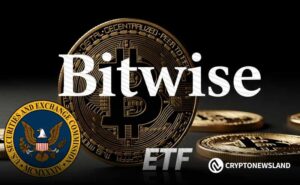
Democrat Ro Khanna Proposes Crypto and Stocks Trading Ban for Elected Officials

